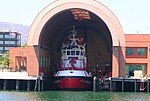Catalina Express
Ferries of CaliforniaSanta Catalina Island (California)Transportation in Los Angeles County, CaliforniaTransportation in Orange County, CaliforniaUse mdy dates from December 2021

Catalina Express (legally Catalina Channel Express) is an American passenger ferry service that operates scheduled trips between Santa Catalina Island and mainland California. The company began service in 1981 with a single sixty-passenger vessel. As of 2016, the Catalina Express fleet includes eight high-speed vessels that can make the roughly 30-mile (48 km) crossing in about an hour.
Excerpt from the Wikipedia article Catalina Express (License: CC BY-SA 3.0, Authors, Images).Catalina Express
Swinford Street, Los Angeles
Geographical coordinates (GPS) Address Nearby Places Show on map
Geographical coordinates (GPS)
| Latitude | Longitude |
|---|---|
| N 33.749675 ° | E -118.278716 ° |
Address
Swinford Street 93
90731 Los Angeles
California, United States
Open on Google Maps







